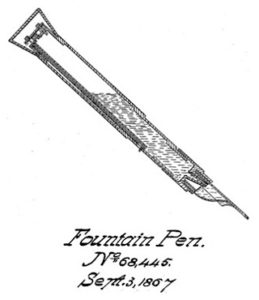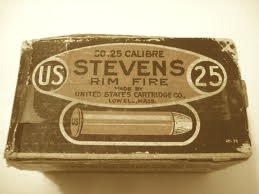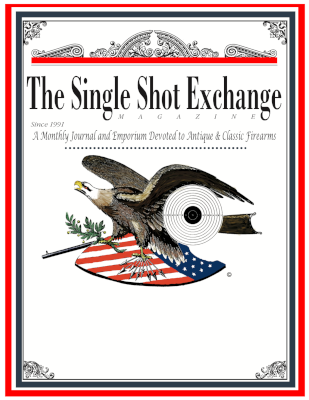Letters & Queries
 One of the great traditions from the journals of the past like Shooting and Fishing (published
One of the great traditions from the journals of the past like Shooting and Fishing (published
between 1885 and 1907) was the “Letters and Queries” column appearing in every issue. Tyros and “gun cranks” of the day asked questions of the readership or shared their experience in a steady flow of interesting and useful information. The Single Shot Exchange has always included this feature in our publication for the very same reason. Personally, I love to do the research on some of the questions and our readership is always ready to jump in with their two cents as well. Here’s a sampling from past issues. [If you live in the digital world of information exchange, you’ll want to click here to check out our blog.]
Shuttleworth to Exchange
Thought I’d share with your readers an experiment I performed to demonstrate the different results in using a powder measure versus weighing charges. With the new electronic weighing systems available, it is not all that much more difficult to weigh powder for single shot rifle target loads. A possible increase in accuracy is very appealing, given the difficulty in achieving very high rest scores.
When benchrest style measures are used with fine grain or ball powders, however, only a small increase in accuracy can be achieved. With coarser grained powders such as #4759, however, consistent charge weights cannot be maintained with any type of volume measure. Recently, I tested the actual weights thrown by a Belding and Mull measure set for 18.2 grains of 4759. Of 50 charges thrown, the variation was from 17.9 grains to 18.4, with a single charge of 18.6 grains. Selecting charges thrown without cutting, moreover, has no effect on accuracy of charges.
With all consideration of actual better accuracy results, it may not make any difference to relate better powder weight consistency to the actual results on the target. The only significant results of better loading techniques are those that show up on the match target; if better score or group results do not occur, why bother? If shooters want to waste time on nonessentials, that does not bother me a bit, although I will not take the time. If cleaning primer pockets improves accuracy, why not prove it? With the extra time required to weigh charges, it would seem worthwhile to see if the results are really better. As a result, I set up an experiment to see how weighing compares to dropping from a measure.
One rifle that I have seems to shoot very well with 4759, and if it will shoot better with weighed charges, then I will weigh them. Score and group shooting from rest requires half minute accuracy as the basis for the rifle. With the rifle shooting this way, the rest is up to the wind doping skill of the shooter. My .38-55 is right on the edge of half minute accuracy, shooting about .6 inches at 100 yards, and smaller is better. Six tens of an inch is an average figure, with some smaller and some larger. Unfortunately, you don’t win matches with “pocket groups” but with consistent small groups.
For the experiment, I loaded 80 trial cases with 18.2 grains of 4759, half weighed on a Lyman weighing machine and half thrown from a Belding and Mull measure. The bullets were 314 grain Hoch .38 tapered bullets cast from 1:24 metal and lubed with Darr lube. All bullets were from one casting lot and weighed, and varied a total of half a grain. Bullets were breech seated in a tapered throat Bresien barrel measuring 1-3/8 inches at the breech. The rest of the rifle was a drawbolted CPA Stevens bench gun equipped with a 36X Unertl telescope. The rifle was cleaned after 40 shots, which is all it requires.
Although the results were not absolutely conclusive, it seems that for this rifle, powder and bullet combination, it is not worthwhile to weigh charges. Of the sixteen groups, those from thrown charges averaged .565 inches, while the weighed ones averaged .595 inches. “But wait,” as the TV advertisers say, “there’s more.” One shot from the weighed loads enlarged the weighed average from .54 to .595 inches. The wild shot is not inherently related to weighing, but to some other factor. If you look at .565 to .54, this is 4.4% smaller a marginal achievement, and not statistically significant, especially since I have disregarded one group.
For those of you who are enamored of low standard deviations, the weighed loads averaged 5.75 versus 8.5 foot seconds for those thrown. Low standard deviations and $2 will get you a beer in most places, but seldom win matches. One of the worst loads I ever tried had standard deviations of 1 or 2. The velocity of the above load was right about 1325 fps instrumental at 10 feet. So what does all this mean? To me it means that I will do some further testing because with my wind doping ability, I need all the help I can get.
Paul Shuttleworth, CPA Corporation, Dingmans Ferry, Pennsylvania
Roland D. to Exchange
Topic: Stock for “Japanese” Winchester 1885
I noted a discussion in your “Letters and Queries” with a Mr. Dorsett. He described a Browning 1885 with a “crescent butt plate” which normally comes with the Browning/Winchester 1885 made in the last several years. I have one in a 45-90 and after searching around, spoke with a representative with Browning/Winchester in Utah (phone 801-876-2711). They said they had a straight stock with a shotgun butt plate and a rubber recoil pad installed. The only downside is that it cost $336.50 – shipping included. I have not installed it as yet but compared it with the crescent butt place stock and it appears to be an exact match. At first I couldn’t see how to get the bolt into the new stock but located a fine slit where, with a little Vaseline the bolt and screw driver will easily fit through. In all respects, it is a factory-made stock. Dr. Roland D., Lincoln, California
Gordon B. to Exchange
Great article by Mr. Keel on the 38-90 in a Winchester Hi Wall. Can you provide his email address? I would like to compare notes and learn from him. I own a wonderful Winchester Hi Wall in 38 Winchester Express or 38-90. It has a 34″, #4 barrel with a perfect bore. The action is case hardened with a single-set trigger. It has a Swiss buttplate, a Lyman #103 tang sight, a Lyman # 6 rear barrel sight and a Winchester globe front sight. Given the barrel weight, Swiss buttplate and single-set trigger, this was set up as a target rifle. I believe it was sent back to the factory for refurbishing at some time because of its excellent condition and some of the stampings have clearly been re-stamped. Nonetheless, it is a beautiful rifle and I have been successful in shooting it accurately. I would appreciate the opportunity to correspond with Mr. Keel due to his expertise. Gordon B., Windham, Maine
Curt H. to Exchange
I have been concentrating on single shot rifle work. My projects include Winchester, Ballards, Remington rollers and Hepburns. A #5 roller converted to 22LR after being in a house fire created a lot of interest at the BPCR Nationals. If you are interested I will send some photos of completed projects along with a little description of the work. Looking at your list of advertisers, most are represented in the work I have been doing. We are very fortunate to have the resources to keep the old rifles shooting that we do. I will be sending in an ad soon to place in the “For Sale” section; it has been very productive for me in the past. Curt H., Silver City, New Mexico
Roger W. to Exchange
A gun writer friend of mine has secured a scope mount for his trapdoor Springfield. This mount is easily installed with the removal of the existing sight and using the original screws to attach the scope mount. For those of us with age-related vision problems and wanting to shoot a trapdoor, this is a good alternative.
Robert C. to Exchange
To Mr. Veselenak whose older revolvers shoot high at 25 yards: the older revolvers were sighted at 50 yards or more. In those days they were built for combat and the manufacturer must have figured if you could hit at 50 yards you could hit at 20 or 25 maybe a little high but still a hit. Remember the Wild Bill Dave Tut fight, it took place at 70 or so yards. I’m making up reduced loads at lower velocity. You will have more time for the recoil to start before the bullet leaves the barrel. Throwing the bullet higher on the target for reduced loads use a lighter bullet as well as a lighter powder charge.
Regarding Mr. Dorsett’s letter, I used a Williams guide receiver sight made for the FN 98 Mauser, fits just like it was made for it on my 78 Browning. I believe the 85 Browning receiver is the same. Concerning the stock, Brownells charges over $300 for a factory replacement so be very careful if you start cutting on it to get it right the first time. I use one of the B-square recoil pad jigs to shape the pad so there is no chance of messing up the stock. Brownells has both the B-Square jig and the Williams guide sights.
I really enjoyed the last couple of the Shooting and Fishing reprints featured in The Single Shot Exchange. I had the fun of shooting a 25 Stevens RF on gray squirrels a lot of years ago. An old gentleman, who had the rifle, had to give up his driver’s license so I would drive him to the woods. He could still spot squirrels with a good pair of binoculars and shoot them with my 22 magnum, usually loaded with 22 WRF. The magnum had a good scope and for several seasons he did all right. I did okay also with his Stevens. It appeared to be a variation of the Favorite. It had a flip-over, beech-type sight (front), pin head and blade, an open sight Stevens25RF(folding) on the barrel. For me it was dead on at 50 feet. The folding tang sight was finely adjustable. We had it on at 40 yards (about as far as we could shoot in the oak groves where we hunted).
The 25 Stevens RF did an excellent job of knocking down squirrels; head shots were no problem with anything but body shots with the 22 mag not so good. The hollow point ruined the squirrel and the solid punched through without knocking the squirrel off his perch. The 25 didn’t tear them up much and did a good job of rocking them out of the trees. Using the 22 WRF in the 22 mag worked good; also, the slower moving blunt lead bullet didn’t do much damage to the meat but still had enough impact to knock the squirrels down. I still use them in my 22 mag when I can find them.
I really liked the .25RF and the owner had the foresight to buy up several cartons of cartridges before they stopped making them. We were able to shoot the little rifle quite a bit. The last I heard his son still had the rifle and a couple of cartons of ammo. If someone were to introduce the .25 RF I would find a suitable action and get a barrel and reamer as fast as I could to build a rifle for it.
I ran some 22 Hornet cases in a 25-20 die and necked them up to .25. This looks like it would make a nice 25 center fire. If any one out there has built a rifle like this I would like to hear about it. Robert C., Curtin, Oregon
Ralph G. to Exchange
As always, I enjoyed reading the last issue. In response to Mr. Frantz’s request for data, if he can get a copy of the No. 4 Speer wildcat reloading manual he will find what he is looking to obtain. I haven’t been able to find any data for the 22 Neidner. If he cannot find this manual, have him contact me and I’ll send him a copy. By the way, Jack First Gunshop in Rapid City, South Dakota has a number of original 25-20 single shot cases. Don’t know the quantity or price, but could check if anyone is interested. Ralph G., Keystone, South Dakota
DuWayne K. to Exchange
Thanks for your help in getting my subscription for The Single Shot Exchange in order and for sending the John Meyers book. Your publication is well worth the wait between each monthly issue! From the moment I open the cover I find myself drifting back to another era which I find most relaxing and enjoyable. Now I have a nice backlog of enjoyable reading for the very cold winter days that have set in. DuWayne K., Beaver Dam, Wisconsin



